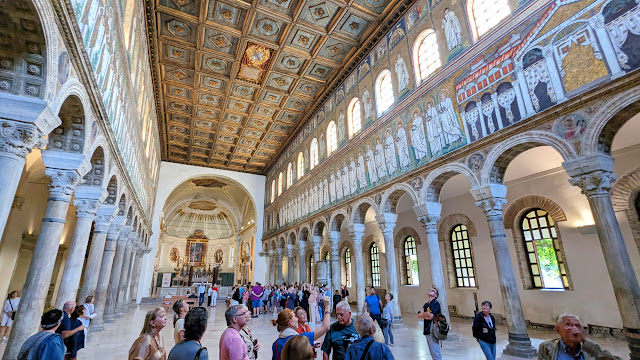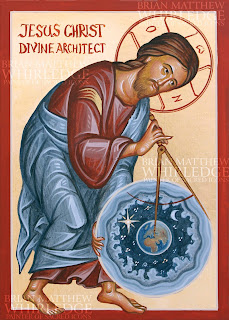Ravenna, Day One
For many years, I’ve dreamed of visiting Ravenna to see her many masterpieces. Ravenna contains a treasure trove of quite early Byzantine and Christian art. The artwork here has survived over 1,400 years, providing a rare glimpse into the origins of Christian sacred art. This important city has seven important monuments showcasing 6th century mosaics. We can see trends in early Christian art that died out and others that have survived and grown until today.
The city of Ravenna was originally the seat of Theodoric’s Gothic kingdom. These Arian Goths (Arians were a heretical Christian sect who denied Christ’s divinity), were ousted by the Roman Empire in 540 during the reign of the Emperor Justinian and Ravenna became the capital of the western exarchate. During the 6th century, many important churches were built and decorated.
The Basilica of Saint Apollinaire Nuovo is quite close to the apartment where we’re staying. It was the first church we visited today. George wanted to come along, since he loves mosaics. I was so proud to see him walk the length of the apartment as we were getting ready. Once we entered the basilica, he walked the entire length of it on his own (several times in fact!). He’s getting so much stronger and more confident walking again after he broke his leg 6 weeks ago.
The basilica plan is longitudinal and naturally directs the attention to the apse at the end. The apse in St. Apollinaire Nuovo is a modern neo-Baroque construction that is utterly unremarkable. However, I was dazzled once I turned my eyes upward to the nave walls to the glittering gold mosaics from the early 6th century.
The upper tier contains the life of Christ. The north (left) side shows miracles and parables, while the south (right) side shows the Passion and Resurrection cycle. The north side shows a beardless Christ in imperial purple; but he is bearded on the southern side. Curiously, there is no depiction of Christ’s Nativity, Baptism, and Crucifixion. The Passion narrative shows the Last Supper, the betrayal in the Garden of Gethesemane, the trial, and carrying the Cross. The very next panel is the Angel pointing to the Empty Tomb.
Below this band is a row of 32 apostles and prophets, who are anonymous. They are wearing white classical clothing, in stark contrast to the richly colored Christ and Theotokos enthroned in the eastern end of the tier below.
The bottom tier contains a beautiful procession of saints. The north (left) side shows women while the south shows men. The women culminate in the Theotokos enthroned, while the men are directed to Christ enthroned. The women saints are all nearly identical, as are the men (with the exception of St. Martin, and some have white hair). Before the Theotokos (and the Christ child on her lap) are the three Magi. It is the earliest time they are named. They are wearing phrygian caps and exotic clothing I’ve wanted to see this mosaic for years, as I have a devotion to the three Magi. It was wonderful to spend some time drawing them.
The church was originally built by Theodoric, and was converted into an Orthodox Church after the Romans retook the city. It was renamed for Saint Martin of Tours, a steadfast defender of Orthodoxy against Arianism, hence his position at the front of the male saints (it was later renamed again for St. Apollinarius when his relics were transferred here from Classe). In the redecoration, the Arian Theodoric and his court were removed from the mosaic of his palace, but some hands and arms were left. It was a real delight to see this curious mosaic in person, since it depicts an actual building next door as well as the historical complexities.
Next, we visited the Orthodox Baptistry, also called the Neonian Baptistry. It is a small octagonal building near the cathedral that seems to be a repurposed bath from the ancient Roman period. The dome shows the Baptism of Christ. Below this are the twelve apostles. Between the windows are sixteen saints (perhaps prophets) in low relief (but their heads are high relief). Around the bottom are a number of chapels or altars in niches. The spandrels contain beautifully styled Apostles in white classical clothing in lush floral vines. The figures are not only superbly rendered, but the decor is splendid, with thrones, architecture, gardens, and fountains.
Next to the Orthodox Baptistry is the Cathedral, with the Archiepiscopal Chapel and museum. The tiny chapel was used for private prayer by the archbishops of Ravenna. It is a Greek cross. The dome shows a Cross upheld by four angels. Between them are the four living creatures (Man, Eagle, Ox, and Lion). The short vaults (really not more than arches) show Christ with the Twelve Apostles on the east and west, while the north and south show saints.
The tiny narthex/vestibule is a real treat. The ceiling is filled with birds in vines and flowers. Above the door is a most unusual icon. A beardless Christ is dressed as a soldier, holding his weapon, the Cross. He is crushing the heads of his defeated enemies, referencing Psalm 90/91:13 “You will tread on the lion and the adder; the young lion and the serpent you will trample underfoot. You will tread on the lion and the adder; the young lion and the serpent you will trample underfoot.” I really enjoyed spending a long time sketching this mosaic. It is so fascinating to see early artistic experiments that didn’t catch on, such as a beardless Christ (the imperial style of the day) and his depiction as a soldier. The mosaics in Ravenna show us a glimpse into early Christian art before the current norms were established in the 9th century after iconoclasm.
The archiepiscopal apartments which contain the chapel have been converted into a surprisingly splendid museum. I came just interested in the chapel, but after seeing its treasures, I spent more time in the museum than the chapel. It contains the famous solid ivory throne of Maximian, the Orthodox Archbishop at the time of Justinian, when many of the monuments in Ravenna were built. This throne contains many scenes from the life of Christ and Joseph (from Genesis), carved in exquisite miniature detail. The details are so crisp, I can’t believe they weren’t carved yesterday, let alone 1,500 years ago. The next room has a stone reliquary casket with an early depiction of the adoration of the Magi.
The real treasure of the museum, in my opinion, is the gallery of the mosaics. Evidently, the apse of the cathedral was once fully decorated in mosaics in 1112 by the same masters who decorated Saint Mark’s Basilica in Venice. During renovations in the 18th century, the apse collapsed and almost all the mosaics were lost. The only mosaics to survive in any meaningful way were the Theotokos Orans (hands raised in prayer), and five faces. The real benefit of seeing the mosaics in this context is the intimacy. It is one thing to see the grandeur of the monumental scale of Sant'Apollinare Nuovo; it is quite another to see the mosaics just a few inches away. I could see the craftsmanship and the expert drawing and colors. The life-size icon of the Theotokos is just incredible. I’ll definitely be using this icon as a reference for years to come.
The last monument we visited today was the Mausoleum of Galla Placidia. She was the daughter of Emperor Theodosius the Great (347-395) who died in Rome in 450. While she commissioned this chapel as her mausoleum, it seems unlikely that she or her husband are (or were) actually buried here. This is the earliest monument in Ravenna. Its icon of Christ the Good Shepherd is arguably the most famous mosaic in the city. George really loved it, especially since his preschool is called “Good Shepherd.” It was really special to spend a good long time drawing it.
The mauseleum is tiny and dark, illuminated by windows of translucent alabaster (and some modern electric light). The dome contains a cross and the four living creatures. The upper walls show eight apostles. Opposite the Good Shepherd is an icon of Saint Laurence, an early deacon martyred in Rome by being grilled alive. The decor is lush and verdant, a paradise teeming with vegetable and animal life.
Tomorrow, I look forward to seeing more visions of Paradise in the mosaics in the Apse of Sant’Apollinaire in Classe, the Basilica of San Vitale, and the Arian Baptistry.


























Comments
Post a Comment